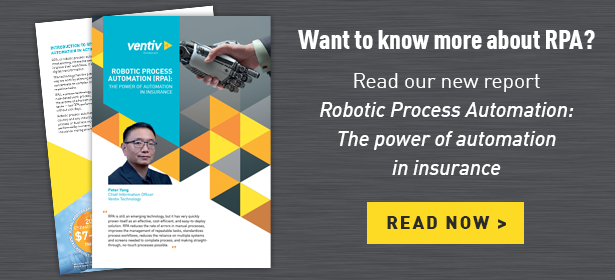Read our overview of RPA from our recent report, Robotic Process Automation (RPA): The Power of Automation in Insurance.

Robotic Process Automation (RPA) uses artificial intelligence (AI) software and machine learning to carry out repetitive tasks with little or no human interaction. (TechTarget). This is particularly useful in industries with a lot of administrative, rule-based tasks where it can allow employees to concentrate on more complex aspects of their role.
RPA is an exciting technology and opens up the opportunities for huge cost and time savings across a business and ultimately, is a big step towards digital transformation. In fact, global consultancy McKinsey predicts that the global robotics automation market will be worth between $7-14 trillion by 2025, which is equivalent to 9-16% of the world’s annual output (Ventiv Technology: Robotic Process Automation (RPA): The Power of Automation in Insurance. Pg. 2).
How does RPA work?
In short, RPA helps to improve workflows across the business, and as it is artificial intelligence, it can perform tasks 24 hours a day. Bots (robots) become virtual workers and can interact with existing systems – often able to link legacy applications with new ones.
Bots are automated programs that can carry out activities such as processing an incoming email or facilitating an online chat. These tasks must be rule-based and repeatable, for example checking an email address against a database. Tasks can be fully automated or use a mixture of human and bot input. The idea is to remove the burden of tasks that currently potentially take up two-thirds of an employee’s day, leaving them to concentrate on more skilled parts of their role (Robotic Process Automation, Pg. 2).
Implementing a successful RPA program does take some planning. If you think that your business can benefit from automation, you will need the help of a specialist technology company who will be able to devise a suitable program, implement and fully test the solution and provide technical support.
While there is concern over security and ensuring there is no technical oversight, the bots are fully monitored and controlled through settings and permissions. If an error occurs, this is logged and the system administrator is notified so it can be corrected.
How can the insurance industry benefit from RPA?
It is possible for more than 40 processes throughout the insurance industry, and financial services as a whole, to become automated (McKinsey, Robotic Process Automation, P. 3).
As well as allowing for better budget planning, improving processes, removing human error and saving time and money, there are other areas specific to insurance that can benefit from automation.
Examples of the types of tasks that could be undertaken by a bot include:
- Processing of insurance certificates or information for renewals and submissions. This can help reduce human error and also standardize the workflow.
- Gathering and entering information on websites, email systems, word processing applications, PDF readers, spreadsheets, and specialized legacy systems such as policy systems (Robotic Process Automation, 3).
RPA in action
Take the task of processing certificates of insurance. When an email is received, a bot can open it and the attachment (such as a Microsoft Word or PDF file). The bot can check all the relevant information required is included. If the document checks all the correct boxes then an automated email is sent to confirm the receipt of the certificate.
Next, the bot can interact with the risk management information system, such as RiskConsole Advance, and saves the document in the correct place for auditing and appropriate access. The bot can also update the appropriate customer record. If the form is incomplete, the bot will be able to respond to the original email explaining the issues with the certificate. (Robotic Process Automation, P.4).
It is not just certificate processing where automation can be key. Claims administration is another area which has a number of manual processes that could be carried out by bots.
Speak to us about Robotic Process Automation
At Ventiv, our specialist team of automation and integration experts, along with our extensive experience in risk and insurance management software and claims administration systems, ensures that we are best placed to help you with your journey into implementing RPA. Contact us to talk about your business.

Peter Yang is Ventiv Technology’s Chief Information Officer. Contact Peter at peter.yang@ventivtech.com













